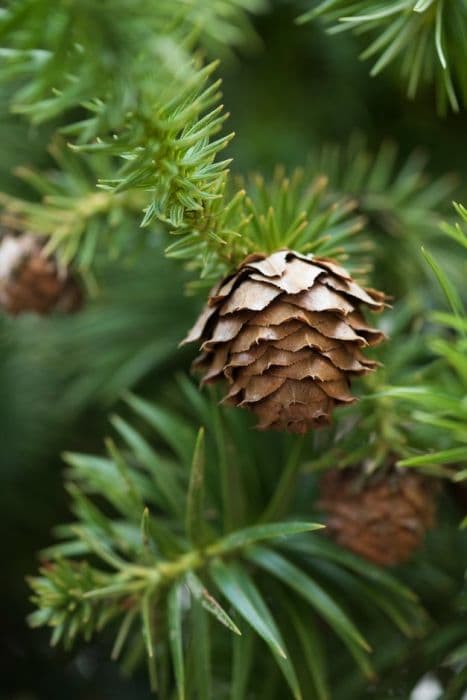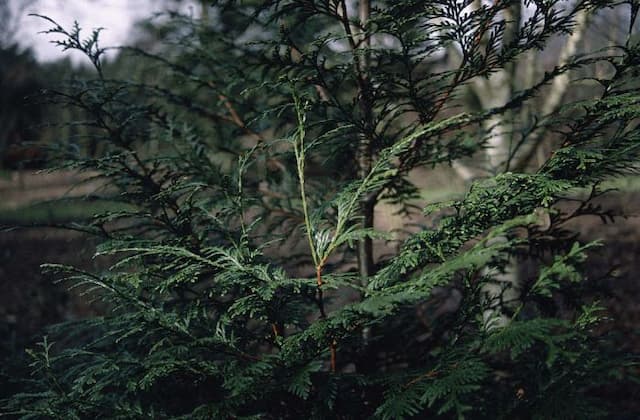Sungold Sawara Cypress Chamaecyparis pisifera 'Sungold'

ABOUT
The Sungold cypress is a cultivar known for its uniquely textured foliage and an overall charming appearance. The plant boasts a dense, fine, and soft fern-like foliage that gracefully spills and mounds, creating a visual softness in the landscape. Its leaves exhibit a golden-yellow hue with hints of lime green, especially vivid in new growth and in full sunlight. This vibrant coloring tends to become slightly more muted as the leaves mature or when the plant is grown in shadier locations. Seasonally, the golden tones can deepen, adding a warm color palette to the garden. The overall shape of the Sungold cypress is rounded, creating a low mound that makes it an attractive specimen for borders, rockeries, and mixed garden beds. The plant's branches are slightly weeping, adding to its soft, textured look, which contrasts beautifully with plants that have darker or more rigid foliage.
About this plant
 Names
NamesFamily
Cupressaceae
Synonyms
Sungold Cypress, Sungold Sawara Cypress, Golden Sawara Cypress, Sungold Thread-Branch Cypress
Common names
Retinispora pisifera, Chamaecyparis pisifera.
 Toxicity
ToxicityTo humans
The Sungold false cypress is considered to have low to no toxicity for humans. Generally, ingestion of this plant does not cause significant symptoms of poisoning and it is unlikely to be harmful if accidentally consumed in small quantities. However, as with any non-food plant, individual sensitivities can vary, and ingesting plant material may potentially lead to nausea, vomiting, or diarrhea due to the mechanical irritation of the digestive tract or minor chemical irritants. If large amounts are consumed, or if any symptoms more severe than mild gastrointestinal upset occur, one should seek medical attention.
To pets
The Sungold false cypress is not known to be toxic to pets. It is not listed amongst the common toxic plants for pets such as cats and dogs. Nonetheless, ingestion of any non-food plant material can lead to gastrointestinal upset, such as vomiting or diarrhea, in pets, particularly if consumed in large amounts. If your pet consumes a significant quantity of the plant, or if they exhibit more severe symptoms, consult with a veterinarian for appropriate care.
 Characteristics
CharacteristicsLife cycle
Perennials
Foliage type
Evergreen
Color of leaves
Golden
Height
4-5 feet (1.2-1.5 meters)
Spread
4-6 feet (1.2-1.8 meters)
Plant type
Shrub
Hardiness zones
4-8
Native area
Japan
Benefits
 General Benefits
General Benefits- Ornamental Appeal: Chamaecyparis pisifera 'Sungold', commonly known as Sawara cypress, features golden-yellow foliage that provides year-round color and visual interest in the landscape.
- Low Maintenance: Sawara cypress requires minimal care once established, making it suitable for gardeners seeking low-effort landscaping options.
- Drought Tolerance: Once established, this plant can tolerate periods of dryness, making it suitable for xeriscaping and regions with water restrictions.
- Pest Resistance: Sawara cypress is known for having good resistance to common pests, reducing the need for chemical treatments.
- Compact Growth: Its slow growth rate and compact habit make it an excellent choice for small gardens or as a specimen in mixed borders.
- Erosion Control: Thanks to its dense root system, Sawara cypress can help stabilize the soil and prevent erosion on slopes and banks.
- Wildlife Shelter: Its dense foliage provides shelter and nesting opportunities for birds and other small wildlife.
- Versatility: Sawara cypress is versatile and can be used in many landscape designs, including formal gardens, Japanese-themed gardens, and as a foundation planting.
- Privacy Screen: When planted in groups, Sawara cypress can form a dense hedge that offers privacy and acts as a windbreak.
- Seasonal Interest: The color and texture of Sawara cypress add interest to the winter garden when many other plants are dormant.
 Medical Properties
Medical PropertiesThis plant is not used for medical purposes.
 Air-purifying Qualities
Air-purifying QualitiesThis plant is not specifically known for air purifying qualities.
 Other Uses
Other Uses- Wildlife Habitat: Sungold cypress provides cover and nesting opportunities for birds and small mammals in the garden.
- Model Landscaping: This plant can be used in scale models or railroad gardens due to its fine texture and slow growth habit.
- Sound Barrier: When planted in rows, Sungold cypress can help dampen noise from nearby streets or neighbors.
- Privacy Screen: Because of its dense foliage, it can be used to create a living privacy screen in residential areas.
- Bonsai: With its small scale and tolerance for pruning, this variety is well-suited for the Japanese art of bonsai.
- Windbreaks: In coastal or windy areas, Sungold cypress can be used as a windbreak to protect more delicate plants.
- Artistic Inspiration: Its unique golden foliage and texture can inspire artists and photographers.
- Thematic Gardens: Sungold cypress can be a feature plant in a golden-themed garden, providing year-round color.
- Topiary: They can be pruned into ornamental shapes for traditional or contemporary garden design.
- Cultural Symbolism: In some cultures, evergreens like Sungold cypress symbolize longevity and can be planted for symbolic value.
Interesting Facts
 Feng Shui
Feng ShuiThe Sungold False Cypress is not used in Feng Shui practice.
 Zodiac Sign Compitability
Zodiac Sign CompitabilityThe Sungold False Cypress is not used in astrology practice.
 Plant Symbolism
Plant Symbolism- Longevity: As a slow-growing conifer, the Sungold cypress is often seen as a symbol of longevity and endurance due to its potential to live for many years.
- Resilience: Their ability to withstand harsh conditions and remain evergreen throughout the year represents perseverance and the capacity to withstand adversity.
- Peace: The soft foliage and serene appearance of the Sungold cypress can evoke a sense of calm and tranquility, symbolizing peace and relaxation.
 Water
WaterThe Sungold Cypress should be watered regularly, especially during its first growing season to establish a deep, extensive root system. Once established, they are relatively drought-tolerant and may only need additional water during extended periods of drought. It's important to water the plant deeply, providing about 1-2 gallons per week depending on the size of the plant and weather conditions. Avoid overwatering, as this can lead to root rot. It is best to check the soil moisture by feeling the soil; it should be moist but not soggy.
 Light
LightSungold Cypress thrives in a spot with full sun to partial shade. The ideal location receives morning sunlight and some afternoon shade, especially in hotter climates to prevent scorching. However, it can also tolerate full sun conditions well, which can encourage better leaf color and denser foliage growth.
 Temperature
TemperatureSungold Cypress is hardy and can tolerate a range of temperatures, generally from -20 to 60 degrees Fahrenheit. The ideal temperature range for this conifer is between 40 and 70 degrees Fahrenheit. Extreme heat can cause stress, and it's important to provide sufficient water during hot spells to maintain health and hydration.
 Pruning
PruningPruning the Sungold Cypress is generally done to maintain its shape and to remove any dead or damaged branches. It's best to prune in late winter or early spring before the onset of new growth. The frequency of pruning will depend on the desired shape and size but is commonly done annually or as needed. It's important to use clean, sharp tools to make precise cuts.
 Cleaning
CleaningAs needed
 Soil
SoilThe Sungold Cypress prefers a moist, well-drained soil with a mix of peat, coarse sand, and pumice to ensure good aeration and drainage. The ideal soil pH for the Sungold Cypress is slightly acidic, ranging from 5.5 to 6.5. Incorporating organic matter into the soil can also help to maintain the necessary moisture and nutritional levels.
 Repotting
RepottingThe Sungold Cypress should be repotted every 3 to 4 years to prevent root-bound conditions and to replenish the nutrient-rich soil. Younger plants may need more frequent repotting, while mature plants can be repotted less often as their growth rate slows.
 Humidity & Misting
Humidity & MistingThe Sungold Cypress thrives in moderate humidity levels and does not require excessively high humidity. Providing an outdoor environment that replicates its natural habitat, or a general garden setting where the air circulation is adequate, will fulfill its humidity needs.
 Suitable locations
Suitable locationsIndoor
Place in bright light, avoid dry heat; mist leaves.
Outdoor
Full sun to part shade; protect from harsh winds.
Hardiness zone
4-8 USDA
 Life cycle
Life cycleThe life cycle of the Sungold Sawara Cypress (Chamaecyparis pisifera 'Sungold') begins with seed germination, occurring when conditions are optimal, usually in a moist, well-drained environment. After germination, the seedling stage follows, characterized by the development of the plant’s first leaves and root system. The seedling then enters a period of rapid growth, known as the juvenile stage, where it progressively forms a shrubby structure with bright golden-yellow foliage. As the plant matures into the adult stage, it becomes more robust and assumes its characteristic mop-like, dense, fine-textured form, reaching up to 3 to 4 feet in height and 4 to 5 feet in width. Reproductive maturity is attained as the adult Sungold Sawara Cypress produces small, inconspicuous cones, completing its reproductive cycle. The plant has a long life span and, under ideal conditions, can live for several decades, continuing to grow and reproduce, with minimal major changes once it reaches maturity.
 Propogation
PropogationPropogation time
Early Spring
The most popular method of propagating the 'Sungold' Sawara cypress involves taking semi-hardwood cuttings. This process usually takes place in late summer to early fall, when new growth has begun to harden. Cuttings of about 4 to 6 inches (10 to 15 cm) are snipped from the parent plant, ensuring that several sets of leaves are present. The lower leaves are removed, and the cut end is dipped in rooting hormone to enhance root development. The prepped cuttings are then inserted into a well-draining soil mix and kept in a humid, warm environment with indirect light. After a few weeks to several months, roots will develop, and the cutting can eventually be transferred to a more permanent location.









